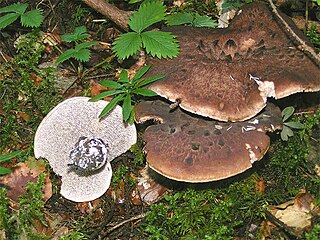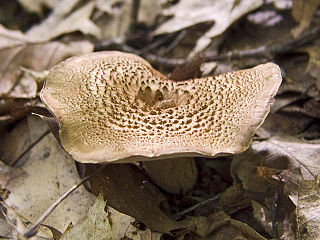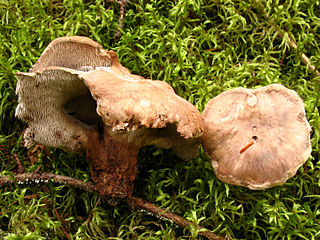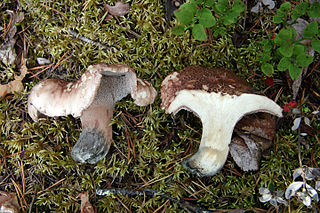
Belize is a Caribbean and Central American country on the north-eastern coast of Central America. It is bordered by Mexico to the north, the Caribbean Sea to the east, and Guatemala to the west and south. It also shares a water boundary with Honduras to the southeast. It has an area of 22,970 square kilometres (8,867 sq mi) and a population of 441,471 (2022). Its mainland is about 290 km (180 mi) long and 110 km (68 mi) wide. It is the least populated and least densely populated country in Central America. Its population growth rate of 1.87% per year is the second-highest in the region and one of the highest in the Western Hemisphere. Its capital is Belmopan, and its largest city is the namesake city of Belize City. Belize is often thought of as a Caribbean country in Central America because it has a history similar to that of English-speaking Caribbean nations. Indeed, Belize’s institutions and official language reflect its history as a British colony.

The Thelephorales are an order of fungi in the class Agaricomycetes. The order includes corticioid and hydnoid fungi, together with a few polypores and clavarioid species. Most fungi within the Thelephorales are ectomycorrhizal. None is of any great economic importance, though Sarcodon imbricatus is edible and commercially marketed, whilst several species have been used for craft dyeing.

Sarcodon imbricatus, commonly known as the shingled hedgehog or scaly hedgehog, is a species of tooth fungus in the order Thelephorales. The mushroom is edible. Many sources report it has a bitter taste, but others have found it delicious and suspect that the bitter specimens may be similar related species. The mushroom has a large, brownish cap with large brown scales and may reach 30 cm (12 in) in diameter. On the underside it sports greyish, brittle teeth instead of gills, and has white flesh. Its spore print is brown. It is associated with spruce (Picea), appearing in autumn. It ranges throughout North America and Europe, although collections from the British Isles are now assigned to the similar species Sarcodon squamosus.

Sarcodon is a genus of fungi in the family Bankeraceae, which is part of the order Thelephorales known for its almost universal ectomycorrhizal life style. The genus owes its name to the presence of teeth-like spines on the hymenophore, it is derived from ancient Greek; sarco = flesh and odon = tooth. This is why they are commonly called "tooth fungi", or "Hydnoid fungi".

Hydnellum fuscoindicum is a species of tooth fungus in the genus Hydnellum. It is found in the Pacific Northwest in moss around western hemlocks. It produces fruit bodies with a violet-black cap, violet flesh, and violet spines on the cap underside. The odor and taste are very farinaceous. The fungus was first described by Kenneth A. Harrison in 1964 as a species of Hydnum, then transferred to Sarcodon in 1967 by Rudolph Arnold Maas Geesteranus. He placed this species in section Violacei of Sarcodon, along with H. fuligineoviolaceum and H. joeides.

Sarcodon atroviridis is a species of fungus in the family Bankeraceae found in North America and Asia. It was originally described in 1895 as Hydnum atroviride by Andrew Price Morgan. Howard James Banker transferred it to Sarcodon in 1906. The fungus is known from Asia and North America; in 2015 it was reported from Brazil. The specific epithet atroviridis means "blackish green". While not explicitly known to be poisonous, it is considered of poor edibility.

Hydnellum underwoodii is an inedible species of tooth fungus in the family Bankeraceae. Found in North America, it was described as new to science in 1906 by American mycologist Howard James Banker. Its reddish-brown, convex to flattened cap measures 5–14 cm (2.0–5.5 in) in diameter. Reddish-brown, partially erect scales adorn the cap surface. Spines on the cap underside are 1–3 mm long; they are initially white, becoming brown with grayish tips in age. The oval to spherical spores are 6–7.5 by 5.5–6.5 µm. The fungus fruits singly or scattered, on the ground in coniferous forests.

Sarcodon stereosarcinon is a species of tooth fungus in the family Bankeraceae. Found in North America, it was described as new to science in 1940 by mycologist Lewis Edgar Wehmeyer, who found the original collections in Nova Scotia, Canada.
Sarcodon umbilicatus is a species of tooth fungus in the family Bankeraceae. Found in Belize, where it grows on the ground under oaks in mountainous cloud forest, it was described as new to science in 2015.
Sarcodon portoricensis is a species of tooth fungus in the family Bankeraceae. Found in Puerto Rico, where it grows on clay soils of low-elevation wet forests, it was described as new to science in 2015.
Sarcodon pakaraimensis is a species of tooth fungus in the family Bankeraceae. Found in Guyana, where it grows in mixed Pakaraimaea–Dicymbe forest, it was described as new to science in 2015. It is differentiated from other Sarcodon species by its smooth to pitted, pinkish-gray cap that stains black, its hollow stipe, and the pink staining reaction of injured flesh. Its spores measure 5–7 µm long by 5–9 µm wide. They make a fresh dark reddish-brown spore print, which tends to lighten to yellowish brown when it is dry. Molecular analysis of DNA sequences shows the fungus to be closely related to S. umbilicatus. The specific epithet pakaraimensis refers to the Pakaraima Mountains—the type locality.

Hydnellum amygdaliolens is a species of tooth fungus in the family Bankeraceae. Found in the Iberian Peninsula, it was described as new to science in 2011. It smells strongly of bitter almonds. Its spores measure 5.25–6.5 by 4.5 μm.
Sarcodon roseolus is a species of tooth fungus in the family Bankeraceae. Found in North America, it was described as new to science in 1913 by mycologist Howard James Banker, who collected the type specimens in North Carolina.

Sarcodon rimosus, commonly known as the cracked hydnum, is a species of tooth fungus in the family Bankeraceae. Found in the Pacific Northwest region of North America, it was described as new to science in 1964 by mycologist Kenneth A. Harrison, who initially called it Hydnum rimosum. He transferred it to the genus Sarcodon in 1984. Fruit bodies of S. rimosum have convex to somewhat depressed caps that are 4–12 cm (1.6–4.7 in) in diameter. The surface becomes scaly in age, often developing conspicuous cracks and fissures. It is brown with violet tints. The flesh lacks any significant taste and odor. Underneath the cap cuticle, the flesh turns a bluish-green color when tested with a solution of potassium hydroxide. The brownish-pinks spines on the cap underside are typically 2.5–7 mm long, extending decurrently on the stipe. Spores are roughly spherical with fine warts on the surface, and measure 5–6.5 by 4.5–5 µm. The hyphae do not have clamp connections.
Sarcodon lanuginosus is a species of tooth fungus in the family Bankeraceae. It was described as new to science in 1961 by mycologist Kenneth A. Harrison, who initially called it Hydnum lanuginosum. He transferred it to the genus Sarcodon in 1984. It is found in Nova Scotia, Canada, where it fruits on the ground singly or in groups under spruce and fir. The type collection was made in Cape Split, Kings County.

Sarcodon calvatus is a species of tooth fungus in the family Bankeraceae. It was described as new to science in 1964 by mycologist Kenneth A. Harrison, who initially called it Hydnum calvatum. He transferred it to the genus Sarcodon in 1984. It is found in North America.
Sarcodon wrightii is a species of tooth fungus in the family Bankeraceae. It was first described in 1860 by Miles Berkeley and Moses Ashley Curtis as Hydnum wrightii. They were sent a specimen collected from Japan as part of the North Pacific Exploring and Surveying Expedition (1853–56). Rudolph Arnold Maas Geesteranus transferred it to the genus Sarcodon in 1967. The fungus produces roughly spherical spores that are tuberculate and measure 5.5–6.5 by 4.5–5.5 μm.

Sarcodon thwaitesii is a species of tooth fungus in the family Bankeraceae. It is found in Asia, Europe, and New Zealand, where it fruits on the ground in mixed forest.
Sarcodon scabripes is a species of fungus in the family Bankeraceae found in Asia, Europe, and North America. It was originally described in 1897 as Hydnum scabripes by Charles Horton Peck. Howard James Banker transferred it to the genus Sarcodon in 1906. The fungus makes fruit bodies with a drab gray to flesh-colored cap, and flesh that is white. In addition to the United States, where it was first documented, S. scabripes has been reported from Japan and the Sverdlovsk Oblast region of Russia.

Hydnellum scabrosum, also called bitter tooth or bitter hedgehog, is a species of tooth fungus in the family Bankeraceae.












